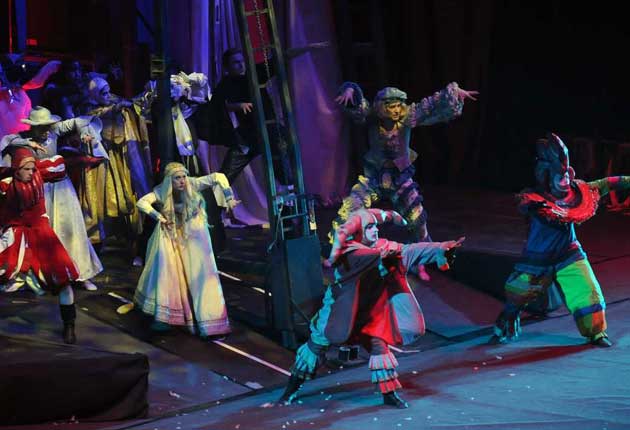Carmina Burana, O2 Arena, London
A funny way to perform opera's sexiest romp

To anyone concerned about dwindling audiences for classical music, it can only be heartening to see some 14,000 people streaming into the O2 Arena to hear one of the 20th century's most influential choral works. The impresario Franz Abraham's "monumental opera" production of Carl Orff's Carmina Burana has been doing the rounds since 1995, but this was London's first experience of it; and if dazzling visuals really are the way to draw new enthusiasts to great music, this heady offering is certainly on the right track.
Orff's work, though, isn't an opera at all, monumental or otherwise. And nor is this. If anything, it's closer to ballet, but one without noteworthy choreography or dancing. The real spectacle lies in the lavish costumes, the tall wooden scaffold that houses the flaming Wheel of Fortune and doubles up as a castle, and, above all, the lighting, fabulously designed by Rainer Casper.
Rainbows of colour blend together across billowing dry ice and the occasional twinkle of fire and firework, creating a synaesthetic experience that truly is tinged with magic. The ship of "Estuans interius" is poetically evoked with long, flowing banners draping from the tower and fluttering through a misty wash of turquoise, pink and violet. The moments evoking puppet theatre and shadowplay at the start of the "Cour d'Amour" are in keeping with Orff's own ethos – Tony Palmer's recent documentary about his life, O Fortuna, has shown how effectively Orff used these mediums in other works. And the gorgeous "In trutina" is portrayed with a flying mobile device that drew sighs of delight from the entranced audience.
This is Carmina Burana for all, and that's great – it's a popular piece, everyone knows the "O Fortuna" chorus from all those adverts and horror movies, and it's a good family evening out.
Or is it? As if Carmina Burana has met High School Musical, the work has been almost impossibly sanitised – the equivalent of pulling a hefty proportion of its teeth. The trouble is that Carmina is one of the most sexually explicit pieces of music ever composed, packing a huge punch both musically and verbally – its medieval-Latin texts, if translated, tend to cause blushing, blanching and fainting, especially when one recalls that they were found in a monastery. But you'd never guess any of that from the jolly carts, ribbons and jesters, the funny little knights toppling each other from toy horses, the skipping cupids, with a little devil-on-angel action being the only obviously suggestive moment. Even this is funny rather than sinister: the angel could be mistaken for a glorified chicken, and does later double up as the unfortunate swan. And the climaxes of 'Veni, veni, venias' are portrayed with games of tag around the schloss, enlivened by strobe lighting. The programme's explanations of the action avoid the original texts like the medieval plague.
The real star was the music itself. With the Royal Philharmonic Orchestra playing its socks off for conductor Walter Haupt, the chief brain behind the whole shebang, and good soloists in the pure-toned soprano Lucia Cesaroni from Canada, tenor Michal Pavel Vojta from Prague, and the German baritone Thomas Berau, who was superb until his voice began to run out two-thirds of the way through, the piece glowed with lyricism and warmth, the strings rich-toned, the Brighton Festival Chorus giving their enthusiastic all. Even so, the violent undertones were ironed flat, the sexual drive muted to fit the mass-market comfort zone.
But Carmina Burana isn't comfortable music, and not only because the Nazis loved it so much, or because Orff himself was a fairly odious character. To turn a work about sex and violence, into an eye-pleasing medieval fantasy evokes only a small proportion of the original's nature. I would replace the stylised cavorting with a genuine ballet, and attempt to balance the concept with the work's darkness as well as its light. And print a translation of the Latin texts. That would cause a sensation.
Join our commenting forum
Join thought-provoking conversations, follow other Independent readers and see their replies
Comments
Bookmark popover
Removed from bookmarks